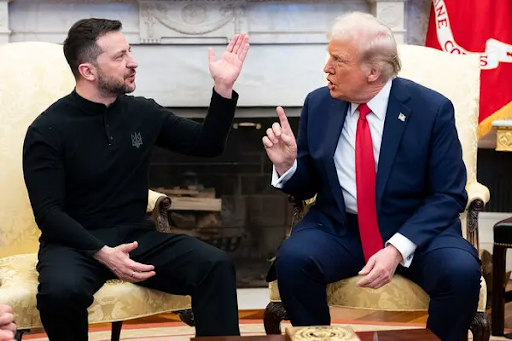
After three years of war, tensions boiled over on February 28th in a diplomatic meeting between President Zelensky of Ukraine and President Trump. The two leaders met in the Oval Office to discuss ending the war between Russia and Ukraine and a rare minerals deal that would help repay the U.S. for their military support to Ukraine.
Once the leaders sat down and exchanged formal pleasantries, the conversation quickly escalated into a fiery confrontation. Trump and Vice President Vance, in a highly unusual display of emotion, berated Zelensky for not being thankful enough for US support. Trump told Zelensky, “You’re gambling with World War III. And what you’re doing is very disrespectful to the country, this country that’s backed you far more than a lot of people said they should have.” He then went on to scold and pressure Zelensky into signing a ceasefire.
In recent US history, no other president has lashed out at a foreign leader on camera, especially a country considered to be an ally. In the days following the dramatic White House confrontation, tensions between the two governments increased as Trump halted US military aid and intelligence to Ukraine until he determined that the country “has demonstrated a commitment to peace negotiations”. These recent changes reveal the scope of Trump’s contrasting foreign policy vision from the Biden administration.
These differences have been easily comparable with the war beginning during the last administration. On February 2022, Russia launched a full scale invasion of Ukraine with the aim of overthrowing the Western-aligned government headed by Volodymr Zelensky. Since Ukraine’s independence from the Soviet Union, many segments of Ukrainian society have sought to align with NATO and the EU—institutions viewed as being traditionally “Western.” Vladimir Putin, the president of Russia, cast the war as part of a fight against Western powers, stating that NATO and the EU are “intent on destroying Russia.” Putin, and many elements of Russian society, fear Ukraine will develop a Western-style democracy that will ultimately undermine a Russia-led sphere of influence in Eastern Europe.
Since 2022, Ukraine has managed to defend 80 percent of its territory, relying on the US for 60 percent of their military aid. The Ukrainian military will likely experience a major setback with the pause in military aid to Ukraine. To date, we have provided 66.5 billion dollars in aid since Russia launched their initial attack. An unnamed European official stated that America’s hault of aid to Ukraine will “cause unnecessary civilian casualties, as Ukraine will not be able to defend against Russian air attacks after they run out of air defense missiles.” Trump is pushing for a quick end to the Ukraine war, and the suspended delivery of all US military aid and intelligence is part of a plan to get Ukraine to cooperate with the White House’s peace deal negotiations with Russia.
The Trump Administration’s new approach to the Ukrainian war reveals that Russia is no longer viewed as an adversary, but a potential new ally. Some foreign policy experts think that the Trump administration may be attempting to build a giant, global anti-China coalition, which would include a new partnership with Russia. This surprising decision reveals how Trump has changed the US approach to the war, which has been adversarial since the beginning of the Cold War. Noticeably, these talks of a peace deal began between Trump and Russia without Ukraine involvement. The peace deal does not include any Ukrainian security guarantees which Zelensky mandates should be added to their final peace agreement. Putin has violated ceasefire agreements in the past, such as in 2014 and 2022, and there is no evidence that suggests that he would not violate an agreement again. While the Trump Administration is putting pressure on Ukraine, it doesn’t appear that similar pressure is being applied to Putin or the Russian military; who continue to bomb Ukrainian cities.
Trump’s foreign policy views on the Ukrainian war and support for NATO and the EU vastly differ from the Biden Administration, as well as other recent administrations. Since the end of the Cold War, the US has stood behind the EU and NATO. Now, as the economic gap between Europe and America has widened due to slow European growth, the Trump Administration has turned away from Europe. When it comes to foreign policy, the current presidency is pursuing more isolationist and realist policies as well as not appearing to show an interest in fighting autocracies or advancing democracy in Europe. Perhaps most surprisingly, from blaming Ukraine for the start of the war to praising Putin, President Trump is portraying Russia as a US ally: a nation that most European countries view as a threat.
There is uncertainty as to why Trump has aligned with Russia, and against Ukraine and our traditional European allies. According to Susan Miller, the former head of counterintelligence at the CIA, Trump might envy the power Putin has over his country; a power with no constraints and a power Trump might want for himself. According to The Atlantic, Trump might believe he and Putin have shared anti-woke ideals against the EU liberal establishment. Yet no matter what theory one believes in, it is clear that from not including Ukraine in its own peace negotiations to describing Russia’s missile strike on Ukraine since the cut of military aid as something “anyone would do,” Trump clearly has a favorite side, and it’s not the traditional pro democracy approach of America’s past.

